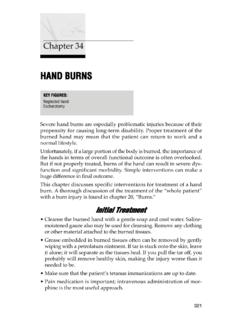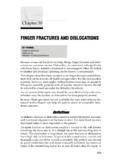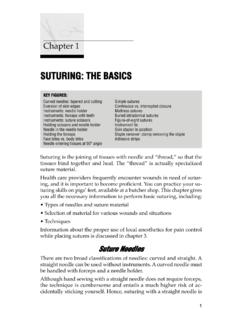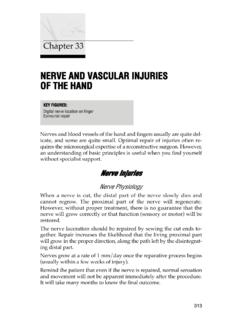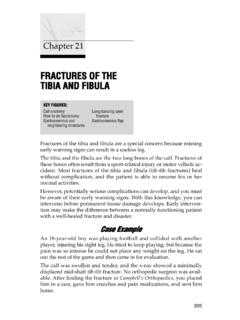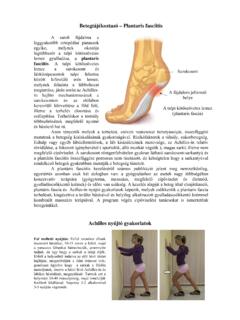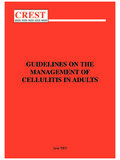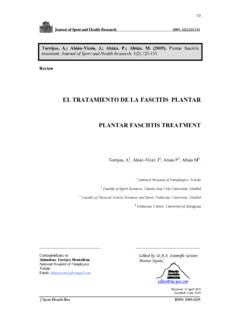Transcription of SOFT TISSUE INFECTIONS - Practical Plastic Surgery
1 SSOOFFTT TTIISSSSUUEE IINNFFEECCTTIIOONNSSSoft TISSUE INFECTIONS can be difficult to treat. All health care providers,especially those practicing in rural settings, must be able to differenti-ate between INFECTIONS that need treatment with antibiotics alone andinfections that require incision and drainage or more radical debride-ment. Serious consequences can result when a severe infection requir-ing operative management is misdiagnosed as a minor infection. CCeelllluulliittiiss AAbbsscceessssCellulitisis a diffuse infection of the soft tissues with no localized areaof pus amenable to drainage. The affected area is described as in-durated ( , warm, red, and swollen). It is also painful. A componentof lymphangitis (infection involving the lymphatics) is indicated byred streaking, progressing proximally from the affected abscessis a localized collection of pus, often with a component ofsurrounding cellulitis (with the above signs).
2 One sign of an abscess isan area of fluctuance; that is, when you apply gentle digital pressureover the area, you can push and feel a give, indicating the presence offluid underneath. Another sign is that an abscess often seems to point; that is, the skin starts to thin from the pressure of the fluid distinction between cellullitis and abscess is important. The maintreatment for an abscess is incision and drainage (cutting into the ab-scess and widely opening the abscess cavity). Cellulitis does not war-rant this term gangrene is used to describe tissues that are dead. There aretwo subtypes of gangrene: dry and wet. The distinction is gangrenedescribes tissues that are generally black and dried out,with a distinct border between dead TISSUE and surrounding healthytissue.
3 Sometimes dry gangrenous tissues fall off on their own (drygangrenous toes can fall off with minimal manipulation). However,183 Chapter 19184 Practical Plastic Surgery for Nonsurgeonsdebridement is usually required, but it is not emergent. Dry gangreneusually places the patient at no health risk as long as it does not becomeinfected (see below).In contrast to dry gangrene, wet gangrenecan be a significant healthrisk. It connotes active infection (noted by pain, swelling, redness, anddrainage of pus) in the tissues surrounding the obviously dead debridement is required to prevent further TISSUE loss andworsening soft TISSUE FFaasscciiiittiissNecrotizing fasciitis is a serious, life-threatening infection of the fascia(the thin connective TISSUE overlying the muscle and under the skinand subcutaneous TISSUE ).
4 The popular press calls it the disease of flesh-eating bacteria. Necrotizing fasciitis is not common, but it must be considered in evalu-ating a patient with a soft TISSUE infection that seems to be progressingrapidly to surrounding tissues. This diagnosis should be consideredwhen the patient is sicker than you would expect for simple skin is swollen but often without many signs of cellulitis. The skinsimply does not look right. You may be able to feel subcutaneous airin the soft tissues, or you may see air in the soft tissues on x-ray (no airis present in normal soft tissues on x-ray).The patient is often quite ill, with high fever, low blood pressure, gen-eral weakness, or even shock, and the infection spreads debridement and even amputation may be necessary to savethe patient s life.
5 Treatment requires aggressive operative debridement (opening the softtissue spaces, as with an abscess) to remove affected TISSUE , intravenousantibiotics, close monitoring of the patient, and aggressive treatment ofsepticemia. Hyperbaric oxygen also may be indicated but does not re-place aggressive operative treatment. Patients with necrotizing fasciitisshould be treated by a surgeon with critical care ooff PPaattiieennttss wwiitthh SSoofftt TTiissssuuee IInnffeeccttiioonnHistoryAntecedent TraumaAsk about traumatic injury to the area before the signs of TISSUE INFECTIONS 185 Cuts from glass and punctures from metal objects should raise concernabout the presence of a foreign body in the soft of an animal bite should raise concern about specific bacterialorganisms that may require a particular antibiotic (see discussion ofspecific treatments below).
6 Medical IssuesInfections in patients with diabetes are often worse than you expect,and more difficult to treat. You must treat these INFECTIONS aggressively,and be sure to control the patient s blood about the patient s tetanus immunization status, and give abooster as ExaminationThe classic signs of infection are redness, warmth, swelling, and pain. Look closely for puncture wounds or other signs of to distinguish between a localized collection of pus that needsdrainage and diffuse infection. Check for fluctuance, as previouslydescribed. Determine whether the induration is spreading to surrounding red streaks extend proximally from the affected area?Feel for crepitus (subcutaneous air) in the soft tissues, which is a signof necrotizing fasciitis. Press on the soft tissues.
7 If air is present underthe skin, it will feel as if you are pressing on crinkled layers of cello-phane or popping air bubbles beneath the the patient for fever, chills, low blood pressure, generalizedweakness, and for enlarged lymph nodes in the surrounding area (groin orarmpit, as appropriate).Determine whether a fluctuant area is present over a pulse point ( ,in the groin over the femoral artery or on the volar aspect of the elbowover the brachial artery).Additional StudiesAdditional studies for all patients should include a complete bloodcount with a white blood cell count and X-ray evaluation of the in-fected Practical Plastic Surgery for NonsurgeonsIf the infectious process overlies a pulse point, the underlying arterymay be involved, resulting in a pseudoaneurysm(an outpouching ofthe artery).
8 Before any surgical intervention, you must evaluate thevessel with an ultrasound/duplex a pseudoaneurysm is present, a surgeon with vascular expertisemust be involved in the patient s care. If you incise and drain the ab-scess without proper equipment and expertise, you will open the bloodvessel, which may result in massive blood loss and death of the to Look for on the X-ray Foreign bodies Unsuspected fractures/dislocations Underlying bone infection (bone edges appear irregular becausebone has been destroyed by infection) Air in the soft tissues (when previous incision and drainage have notbeen done), which strongly indicates necrotizing fasciitis. Localizedair may be present in the soft tissues in the immediate vicinity of anincision and drainage site, but diffuse air in the tissues is a sign of anecrotizing TTrreeaattmmeennttThe patient must be evaluated carefully to distinguish among simplecellulitis, an abscess in need of incision and drainage (I & D), or necro-tizing fasciitis in need of emergent radical the patient is stable with normal blood pressure and has no fluctu-ance,the probable diagnosis is cellulitis.
9 Treatment with antibioticsand warm compresses is indicated. Watch for signs of progression,which may indicate an underlying abscess or need for a change in an-tibiotic the patient is stable but fluctuance is present,the abscess requiressimple I & D. In addition, a short course of oral antibiotics may be the patient is quite ill, with evidence of an abscess or possible signsof necrotizing fasciitis or wet gangrene,he or she requires intravenousantibiotics, intravenous fluids, and urgent operative ttoo AAnnttiibbiioottiiccssAntibiotic administration is often the cornerstone of the treatment ofsoft TISSUE INFECTIONS . The following are general guidelines: soft TISSUE INFECTIONS 1871. Remind the patient that more than one dose of an antibiotic isneeded to see any significant Follow the patient closely because changes in antibiotic therapymay be needed.
10 In addition, an area that you thought was merelycellulitis may show signs of an abscess at a later Whenever possible, send a specimen of any drainage from the areato the lab for aerobic and anaerobic culture and Gram stain. The re-sults of these studies help to guide your choice of antibiotic therapy. Basic Skin InfectionsThe infecting organisms are usually staphylococci or streptococci. Treatwith an extended penicillin (a drug related to penicillin that coverspenicillin-resistant organisms) or a first-generation BitesPasteurellaspp. are associated with cat and dog bites. Treatment re-quires an antipseudomonal antibiotic ( , amoxicillin/clavulanate orcefuroxime). On the hand, cat bites have a much higher incidence ofsubsequent infection than dog bites (80% vs. 5%, respectively).
